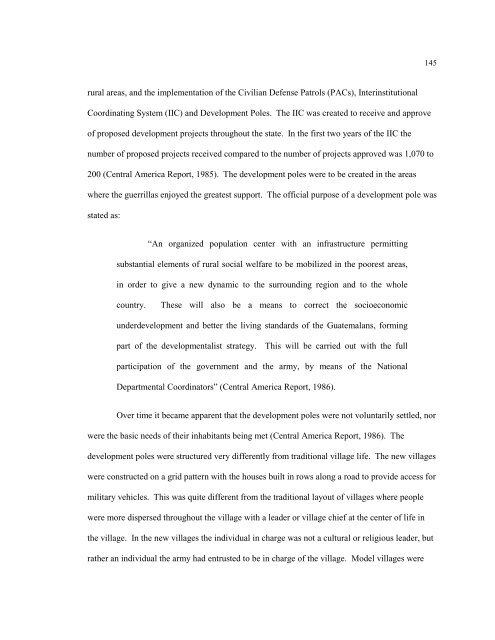Complete Thesis_double spaced abstract.pdf
Complete Thesis_double spaced abstract.pdf
Complete Thesis_double spaced abstract.pdf
Create successful ePaper yourself
Turn your PDF publications into a flip-book with our unique Google optimized e-Paper software.
ural areas, and the implementation of the Civilian Defense Patrols (PACs), Interinstitutional<br />
Coordinating System (IIC) and Development Poles. The IIC was created to receive and approve<br />
of proposed development projects throughout the state. In the first two years of the IIC the<br />
number of proposed projects received compared to the number of projects approved was 1,070 to<br />
200 (Central America Report, 1985). The development poles were to be created in the areas<br />
where the guerrillas enjoyed the greatest support. The official purpose of a development pole was<br />
stated as:<br />
“An organized population center with an infrastructure permitting<br />
substantial elements of rural social welfare to be mobilized in the poorest areas,<br />
in order to give a new dynamic to the surrounding region and to the whole<br />
country. These will also be a means to correct the socioeconomic<br />
underdevelopment and better the living standards of the Guatemalans, forming<br />
part of the developmentalist strategy. This will be carried out with the full<br />
participation of the government and the army, by means of the National<br />
Departmental Coordinators” (Central America Report, 1986).<br />
Over time it became apparent that the development poles were not voluntarily settled, nor<br />
were the basic needs of their inhabitants being met (Central America Report, 1986). The<br />
development poles were structured very differently from traditional village life. The new villages<br />
were constructed on a grid pattern with the houses built in rows along a road to provide access for<br />
military vehicles. This was quite different from the traditional layout of villages where people<br />
were more dispersed throughout the village with a leader or village chief at the center of life in<br />
the village. In the new villages the individual in charge was not a cultural or religious leader, but<br />
rather an individual the army had entrusted to be in charge of the village. Model villages were<br />
145














![Completed Thesis to Grad Studies[Final3].pdf](https://img.yumpu.com/17538645/1/190x245/completed-thesis-to-grad-studiesfinal3pdf.jpg?quality=85)
